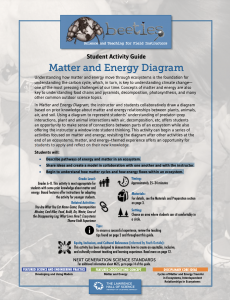Understanding how matter and energy move through ecosystems is the foundation for understanding the carbon cycle, which, in turn, is key to understanding climate change— one of the most pressing challenges of our time. Concepts of matter and energy are also key to understanding food chains and pyramids, decomposition, photosynthesis, and many other common outdoor science topics.
In Matter and Energy Diagram, the instructor and students collaboratively draw a diagram based on prior knowledge about matter and energy relationships between plants, animals, air, and soil. Using a diagram to represent students’ understanding of predator–prey interactions, plant and animal interactions with air, decomposition, etc. offers students an opportunity to make sense of connections between parts of an ecosystem while also offering the instructor a window into student thinking. This activity can begin a series of activities focused on matter and energy; revisiting the diagram after other activities at the end of an ecosystems, matter, and energy–themed experience offers an opportunity for students to apply and reflect on their new knowledge.
Students will…
• Describe pathways of energy and matter in an ecosystem.
• Share ideas and create a model in collaboration with one another and with the instructor.
• Begin to understand how matter cycles and how energy flows within an ecosystem.
Special Acknowledgements
We want to acknowledge Justice Outside for reviewing this session and supporting us to develop more equitable, inclusive, and culturally relevant instructional materials. Read more about our collaboration with Justice Outside.

